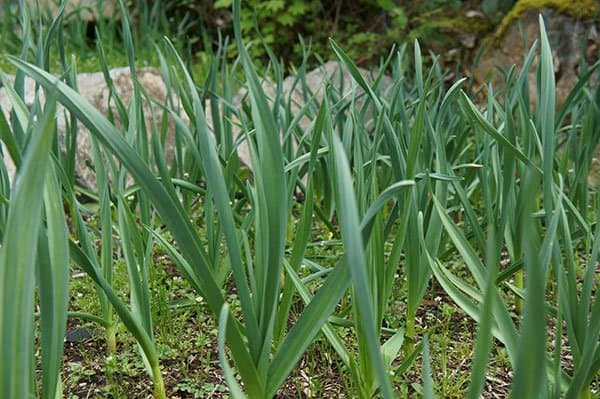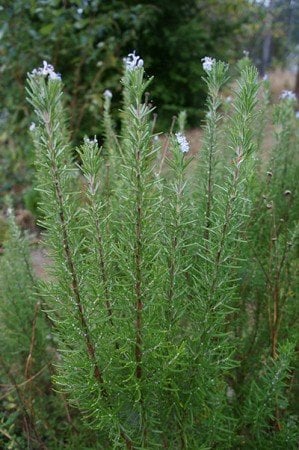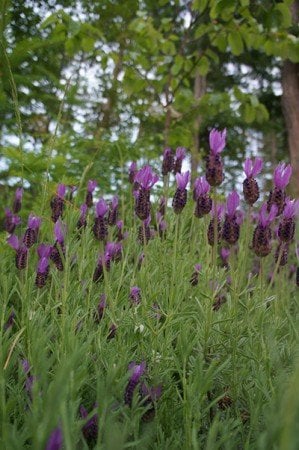Here are more ideas for food to grow where deer roam, including rhubarb, sorrel, garlic and culinary herbs. This is part two. For the first part, go to Growing food where deer roam.
Rhubarb
In the garden, drama queen rhubarb, Zone 5, is also deer and pest resistant, and adapts easily to virtually any spot. I plunk in rhubarb wherever I’m looking for big and bold burst of its rumpled red-stemmed vegetation spring through fall (but where it can quietly die back through winter).
My co-author and gardening pal Sharon Hanna (The Book of Kale & Friends), however, gives rhubarb the royal treatment and enjoys a harvest far lusher than mine. Here are Sharon’s tips:
Rhubarb responds badly to transplanting, so carefully consider where to place it. Prepare a planting hole 18 inches (45 cm) deep and wide. Loosen the soil and enrich it with a few big shovelfuls of compost or well-rotted manure. Set the crowns of rhubarb divisions an inch (2.5 cm) below the soil surface and three to four feet (90 cm to 1.2 m) apart. The crown is the area where stalks grow from, at the top of the rhubarb root. Crowns are fibrous and usually brown, and you don’t want to bury them too deeply. Water well initially and keep moist. Treat rhubarb to half a watering can full of manure/compost tea every other week.
It’s okay to lightly harvest rhubarb’s ruby-red stalks one year after planting. Gradually increase the number you take, but always leave at least four of the biggest stalks. Never eat rhubarb’s leaves. They’re extremely high in oxalic acid, making them very toxic, and should be relegated to the compost.
Wherever and however you plant it, healthy plants usually produce lots of stalks in the fourth year. By the fifth or sixth year, the crowns become woody and production declines — time to divide! In early spring, slice the root clumps into pieces with a sharp spade, or work the twisted roots apart with your hands. Replant these bits, and share the rest with friends. After the leaves die down in fall, bury the crowns with manure, leaf mould, straw, compost or other organic material. Pull the mulch away in early spring, and the cycle begins again.

Red-veined sorrel
Also in the rhubarb family and hardy to Zone 5, perennial red-veined sorrel (Rumex sanguineus) has proven to be deer proof (unlike the more tender and luscious French sorrel that I grow inside my fenced garden). While not as sumptuous to eat as its fancy French cousin, this sorrel is a striking addition to the salad bowl and can be sown wherever you have a spare spot in your garden.

Garlic
Go ahead and plant garlic in the fall for harvesting next summer. Despite browsing through my garlic bed to pick at the weeds between the plants, visiting deer leave my crop intact. Learn more about growing (and eating garlic) at 4 fabulous ways to harvest homegrown garlic.

Culinary herbs
Other alliums, such as chives, are among the many kitchen herbs deer generally pass by. Add to this some lush swaths or pots of deer-hardy mint, oregano, rosemary and thyme. All are are prolific bloomers, culinary godsends and great supporters of bees. Read: 5 bee-supporting perennial edibles to grow
For height in the rear of your garden, add lovage and fennel, both of which provide a statuesque backdrop through the growing season, edible foliage and nourishing seeds to last all winter. Read: Tasty ways to enjoy edible seeds

Sage, rosemary, lavender, lemon catnip, lemon balm, agastache and costmary also join the ranks of kitchen plants that you can grow wherever the deer roam. Try some in a pot to enhance the visual interest in your garden bed. Read: 9 fabulous edibles for container kitchen garden

Leave a Reply